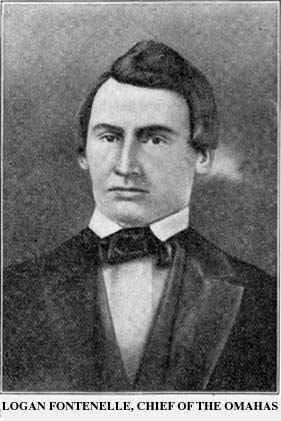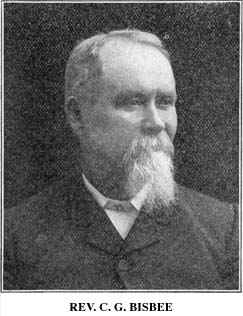
CONGREGATIONAL SCHOOLS IN NEBRASKA
I
CONGREGATIONAL EDUCATIONAL INSTITUTIONS
THE FONTANELLE SCHOOL
At the second meeting of the State Association held at Fremont, October 30, 1857, and called "The First Annual Meeting," a preliminary meeting for organization having been held in Omaha, August 8, 1857, it was
"Resolved, That we deem it expedient to take measures to lay the foundation of a literary institution of a high order in Nebraska.
"Resolved, That a committee of three be appointed to take into consideration the location of the literary institution.
"Resolved, That R. Gaylord of Omaha and P. Allen of Ft. Calhoun be two of this committee, and that Brother Gaylord select the other in Omaha. Voted, That this committee view locations, receive propositions, and, if thought expedient, call a special meeting of the association."1
This is the first record of action looking toward Congregational education in Nebraska. Our pioneer fathers could not well be good Congregationalists without building a college.
True to the historic spirit of the denomination they began building up a Christian school as soon as they were organized into an association of churches.
In compliance with the preceding resolution Moderator Gaylord called a special meeting of the association at Fontanelle, January 5, 1858, to consider the question of founding an institution of learning.
201
| 202 |
CONGREGATIONAL NEBRASKA
|
Mention has been made in a preceding chapter2 of the effort of Dr. John M. Ellis to locate a colony and establish a Congregational college. A year earlier than that, "on the 24th day of June, 1854, less than thirty days after the

passage of the Kansas-Nebraska act, a little company of Quincy (Illinois) people met together and organized the 'Nebraska Colonization Company.' "3
|
THE FONTANELLE SCHOOL
|
203
|
This company, in carrying out their project, located, September f5 of the same year, the town of Fontanelle on the east side of the Elkhorn river a few miles northwest of Omaha, and named after Logan Fontenelle, a half-breed Indian, chief of the Omaha tribe, who had rendered them valuable assistance. There a tract of 112 acres was set apart for Nebraska University. Says Prof. A. B. Show: "It would be difficult to find a more satisfactory location for a college. The westward view is broad and charming, embracing in its sweep not only the Elkhorn and its tributaries, but also the wide valley of the Platte many miles to the south. It did not seem visionary to expect that some day a half score of substantial college buildings would look down from this height upon a thickly populated and prosperous community."4
Rev. W. W. Keep, a Baptist clergyman, was one of the leading promoters of the colony, trustee and financial agent of the university, and it may be it was intended to establish a Baptist colony and build up a Baptist college. Professor Show says: "The evidence is not clear and satisfactory.
In the first board of trustees of which a record remains, that of 1856-57, three out of eight trustees were already members of the Fontanelle Congregational Church and two others were members before 1860. In the next board of trustees, elected before the question of transferring the management had been raised, five out of eleven were Congregationalists, but the chairman, Rev. J. M. Taggart, was a Baptist clergyman."5
| 204 |
CONGREGATIONAL NEBRASKA
|
The first church organized in Fontanelle6 was Congregational, and "quite a number of these were from the Congregational Church of Quincy, Illinois,"7 showing that they were a part of the colony.
The First Church in Omaha was organized May 4, 1856. One week later the church in Fontanelle was organized with twenty-three members.
It is quite evident that Congregationalists predominated in influence, for when Mr. Gaylord called a special meeting of the State Association at Fontanelle, January 5, 1858, the Nebraska Colonization company and the trustees of Nebraska University were ready with proposals to transfer the college to the Congregationalists. In view of these proposals and of donations by the citizens of Fontanelle, the association voted, January 6, 1858, to locate the college at Fontanelle, Dodge county, Nebraska.8 The next day the association considered the question of a charter for the new college, appointed a committee to look after the matter, and instructed the moderator and clerk, as a committee, "to draw up and arrange a contract with the previous trustees and Nebraska Colonization company."9
In accordance with this contract10 the State Association of Congregational Churches undertook to erect a "building for a preparatory department of sufficient dimensions to accommodate 100 pupils" before the third Monday of the next October, and "a good and substantial building for college purposes of architectural proportions" within a period of five years.
The revised charter of the Nebraska University secured by act of the legislature October 25, 1858, "changed en-
|
THE FONTANELLE SCHOOL
|
205
|
tirely the mode of electing trustees, that power henceforth being vested solely in the Congregational Association."11 In the Ft. Calhoun meeting of the association, October, 1858, "much interest was manifested concerning the present and future prosperity of the institution."12 It was now a child of the church, and had a lofty ambition to become a leading western college.
A series of misfortunes made its history a checkered one. Hard times interfered with its material advancement; the discovery of gold at Pike's Peak took away many of the inhabitants of Fontanelle; the Indian scare of 1859 had a depressing effect; and, above all, in 1860 it was, by act of legislature, detached from Dodge county and made a part of Washington county. The coveted county seat of Dodge county went to Fremont, which secured also the Union Pacific railroad, leaving Fontanelle to one side and with hopes of the future largely blasted. College work was suspended for a time, debts increased, and Mr. Gaylord became actively engaged in securing funds from the East:
While these changes and disappointments "proved the death blow to the future prospects of Fontanelle as a city,"13 yet the pioneer churches stood by the infant college with a heroism worthy of larger results.
In 1864 the school resumed work under Miss A. B. Savage, who had charge of the "preparatory and ladies' department," and in the following spring Prof. Henry E. Brown, a graduate of Oberlin College, was engaged as "professor of languages and principal of the preparatory department." Professor Brown began work in midwinter (1866?), and he and Miss Savage continued the work until the spring of 1867, when Professor Brown retired from the school.
| 206 |
CONGREGATIONAL NEBRASKA
|
Rev. Charles C. Bisbee, who for a year had been pastor of the Fontanelle Church, assumed charge of the school, and remained for some three years.
"He was assisted in teaching by Mrs. Bisbee, Miss Sarah Jenny, Rev. J. F. Kuhlman, and perhaps others. The

records do not indicate precisely the attendance of students during these years. Obviously, in that respect it was the most flourishing period in the life of the school, but at the best the number was small."14
Rev. C. G. Bisbee now resides in Arlington, and writes :15